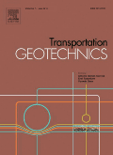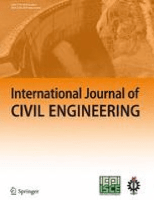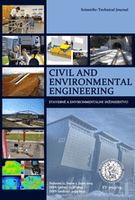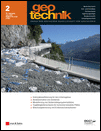
Transportation Geotechnics
Scope & Guideline
Advancing the Future of Infrastructure Stability.
Introduction
Aims and Scopes
- Geotechnical Performance of Transportation Infrastructure:
The journal emphasizes research on the geotechnical aspects of roads, railways, and tunnels, including the analysis of soil behavior under various loading conditions, environmental factors, and construction methods. - Innovative Materials and Stabilization Techniques:
A significant focus is on developing and assessing new materials and stabilization methods for improving the performance of soil and aggregate materials used in transportation infrastructure. - Impact of Climate Change on Infrastructure:
Research addressing the effects of climate change on soil mechanics and infrastructure resilience is increasingly prominent, reflecting the need for sustainable practices in geotechnical engineering. - Machine Learning and Data-Driven Approaches:
The journal showcases advancements in machine learning applications for predicting soil behavior, material performance, and infrastructure monitoring, indicating a shift towards data-driven methodologies in geotechnical research. - Field Studies and Real-World Applications:
Field investigations and case studies are a crucial part of the journal, providing practical insights into the performance of transportation systems and informing future designs.
Trending and Emerging
- Sustainable and Green Engineering Solutions:
There is a growing emphasis on sustainable practices, including the use of recycled materials, biopolymers, and environmentally friendly stabilization techniques to enhance the resilience of transportation infrastructure. - Smart Technologies and Monitoring Systems:
The integration of smart technologies, including sensor systems and real-time monitoring of infrastructure performance, is a trending theme, highlighting the importance of data collection and analysis in modern geotechnics. - Climate Resilience and Adaptation Strategies:
Research focusing on the resilience of transportation infrastructure to climate change, including studies on frost heave, moisture variations, and extreme weather impacts, is increasingly prevalent. - Advanced Computational Methods and Simulations:
There is a significant rise in the use of advanced computational techniques, including finite element and discrete element modeling, to analyze complex interactions in geotechnical systems. - Machine Learning and Artificial Intelligence Applications:
The application of machine learning and artificial intelligence in predicting soil behavior, optimizing designs, and enhancing the performance of transportation systems is gaining momentum, reflecting the shift towards data-centric methodologies.
Declining or Waning
- Traditional Soil Mechanics:
Research focused solely on classical soil mechanics principles without integration into modern applications or innovations is becoming less frequent, as the field evolves to include more interdisciplinary approaches. - Static Analysis Methods:
There is a noticeable decrease in publications centered around static analysis methods for soil and structure interaction, as dynamic and time-dependent analyses gain more attention in the context of real-world applications. - Conventional Materials without Innovation:
Papers focusing on traditional materials without exploring innovative alternatives or enhancements are declining, reflecting a broader trend towards sustainability and material efficiency in geotechnics. - General Reviews without New Insights:
While review articles continue to be valuable, those that do not provide new insights or syntheses of the latest research findings are less common, as the journal increasingly prioritizes original contributions. - Localized Case Studies with Limited Applicability:
Case studies that do not offer broader implications or are not applicable to wider contexts are seeing reduced publication rates, as the focus shifts towards more universally relevant research.
Similar Journals

International Journal of Civil Engineering
Exploring Innovations in Structural and Geotechnical EngineeringThe International Journal of Civil Engineering, published by Springer International Publishing AG, is a premier platform dedicated to advancing the field of civil engineering. With a notable impact factor and a strong reputation reflected in its Q2 quartile rankings in both Civil and Structural Engineering as well as Geotechnical Engineering and Engineering Geology, this journal facilitates the dissemination of high-quality research from 2009 through 2024. Researchers and professionals can access cutting-edge studies and innovative practices that address contemporary challenges in civil engineering, such as sustainable infrastructure development, environmental impacts, and advanced material technologies. Situated in Switzerland, the International Journal of Civil Engineering emphasizes the critical interplay between theory and application, making it an essential resource for students, academics, and industry leaders seeking to stay at the forefront of their disciplines.

CANADIAN JOURNAL OF CIVIL ENGINEERING
Connecting Researchers to the Heart of Civil EngineeringCanadian Journal of Civil Engineering, published by Canadian Science Publishing, serves as a premier platform for the dissemination of innovative research and development in the fields of civil and structural engineering, as well as environmental science. Established in 1971, this journal maintains a robust reputation, achieving a Q3 ranking in both civil engineering and general environmental science categories as of 2023. While it does not currently offer open access, the journal is accessible to a wide audience of researchers, professionals, and students who are keen to stay abreast of the latest advancements in civil engineering practices. With a significant number of yearly publications and a committed editorial board, the Canadian Journal of Civil Engineering contributes to the foundational knowledge and practical applications in the engineering community, thereby playing a critical role in addressing contemporary challenges in civil infrastructure and environmental sustainability.

Innovative Infrastructure Solutions
Pioneering Research for Cutting-Edge Infrastructure Development.Innovative Infrastructure Solutions is a leading academic journal published by Springer International Publishing AG, focusing on pioneering advancements in the fields of building and construction, civil and structural engineering, and environmental engineering. With an impact factor that reflects its significant role in the academic community, this journal serves as a vital platform for researchers, professionals, and students to disseminate groundbreaking studies and novel methodologies spanning diverse engineering disciplines. Since its inception in 2016, Innovative Infrastructure Solutions has steadily positioned itself within the Q2 category across several fields, including geotechnical engineering and engineering geology, as recognized in the 2023 quartiles. This reputable journal, accessible from Switzerland, not only emphasizes collaboration and knowledge exchange but also empowers innovators in infrastructure development globally. Whether you're contributing to a research project or seeking the latest findings, Innovative Infrastructure Solutions remains essential for anyone invested in advancing sustainable infrastructure solutions.

KSCE Journal of Civil Engineering
Pioneering Insights for a Resilient Built EnvironmentKSCE Journal of Civil Engineering is a prestigious international publication dedicated to advancing the field of civil engineering. Established by the Korean Society of Civil Engineers (KSCE), this journal serves as a vital platform for high-quality research in the discipline, showcasing innovative methodologies, case studies, and critical analyses pertinent to civil and structural engineering. With an impact factor placing it in the Q2 category of civil engineering journals for 2023 and a solid Scopus rank of #141 out of 379, it reflects the significant contributions of its authors and the growing recognition of its published works. KSCE Journal of Civil Engineering, based in Germany and easily accessible to the global research community, is committed to disseminating knowledge with rigor and integrity, encouraging both emerging scholars and seasoned experts to contribute to the evolving discourse in civil engineering. With a convergence period from 2009 to 2024, the journal continues to uphold its mission of fostering innovation and excellence in engineering practice.

Civil and Environmental Engineering
Empowering scholars to build a sustainable tomorrow.Civil and Environmental Engineering, published by SCIENDO, is a prominent open-access journal dedicated to advancing research and knowledge in the fields of civil and structural engineering, as well as environmental engineering. Since its inception in Germany, it has been committed to promoting cutting-edge studies and methodologies that address the pressing challenges in these domains. With an ISSN of 1336-5835 and E-ISSN of 2199-6512, the journal is accessible to a global audience, having adopted an open-access policy since 2014 to enhance the visibility and dissemination of scholarly work. The journal currently holds a Q3 ranking in both Civil and Structural Engineering and Environmental Engineering, as of 2023, reflecting its growing influence within the academic community. It operates within a framework of rigorous peer-review standards and encourages contributions that not only contribute to theoretical advancements but also have practical implications for real-world applications. Researchers, professionals, and students alike will find invaluable insights and innovative perspectives in the latest studies published from 2018 to 2024.

International Journal of Physical Modelling in Geotechnics
Elevating understanding of geotechnics through rigorous modeling.The International Journal of Physical Modelling in Geotechnics, published by Emerald Group Publishing Ltd, is a leading platform dedicated to advancing the field of geotechnical engineering and engineering geology. With a focus on the practical applications of physical modeling, this journal contributes significantly to the understanding of soil and rock behavior under various conditions, making it invaluable for researchers, professionals, and students alike. Heightened by its Q2 ranking in its category and a notable 61st percentile ranking among its peers, this journal has established itself as a credible source of knowledge and innovation within the academic community. Although it does not currently offer open access, its rigorous peer-review standards ensure the dissemination of high-quality research and insights. The journal, covering a timeline of topics from 2011 to 2024, aims to bridge the gap between theory and practice, ultimately fostering advancements in geotechnical solutions necessary for infrastructure development. To stay at the forefront of geotechnical research, contributing authors and engaged readers are encouraged to explore and participate in this dynamic academic discussion.

Geotechnik
Unveiling the Science Beneath Our FeetGeotechnik, published by ERNST & SOHN, is a prestigious journal in the field of Geotechnical Engineering and Engineering Geology. With its roots tracing back to 1982 and regular publications since then, it provides a vital platform for researchers, practitioners, and students to share and disseminate cutting-edge findings, methodologies, and techniques. The journal's ISSN is 0172-6145 and the E-ISSN is 2190-6653. Notably, it has achieved a commendable Q3 category ranking in 2023, reflecting its contribution to advancing knowledge in its field, as indicated by its Scopus rank of #171 out of 229 in the Earth and Planetary Sciences category. Although it does not offer open access, the journal remains integral for professionals aiming to stay informed about current trends and breakthroughs in geotechnics. Geotechnik strives to underpin its objectives of fostering quality research and encouraging innovation within the geotechnical community, ensuring it remains a crucial resource for all stakeholders involved.

Acta Geotechnica
Unveiling Insights for Sustainable Geological SolutionsActa Geotechnica, published by SPRINGER HEIDELBERG, is a leading journal in the field of earth sciences and geotechnical engineering, renowned for its rigorous peer-review process and innovative research contributions. With an impressive impact factor and a notable position in the 2023 Category Quartiles as Q1 in both Earth and Planetary Sciences (miscellaneous) and Geotechnical Engineering and Engineering Geology, this journal is pivotal for professionals and academics alike, providing insights that push the boundaries of geotechnical research. The journal features a diverse range of articles, spanning from foundational studies to the latest advancements in sustainable geotechnical practices, making it an essential resource for researchers, practitioners, and students committed to understanding and solving complex geological challenges. The Scopus ranks further affirm its influence, placing it in the 95th and 92nd percentiles of its categories. With no open access options as of now, subscribers gain exclusive access to trailblazing studies aimed at enhancing geotechnical understanding and application globally.

CIVIL ENGINEERING
Pioneering Research for Modern Engineering ChallengesCIVIL ENGINEERING is a prominent journal published by the American Society of Civil Engineers (ASCE), dedicated to advancing the field of civil engineering since its inception in 1969. With an ISSN of 0885-7024, this journal spans a wide range of topics, including civil and structural engineering, geotechnical engineering, and materials science, reflecting its comprehensive coverage of the discipline. Although currently categorized in the Q4 quartile for several fields, the journal provides a platform for researchers, professionals, and students to present innovative solutions and research findings that push the boundaries of civil engineering practices. While it does not offer open-access options, its accessibility through institutional subscriptions ensures that critical research remains within reach for those intent on furthering their understanding and applications in the field. Conference proceeding articles, case studies, and theoretical papers contribute to its mission of fostering communication and knowledge exchange among civil engineering practitioners and scholars. The journal's commitment to quality and relevance in today's evolving engineering landscape makes it an essential resource for informed decision-making and professional development.

Journal of the Korean Geosynthetic Society
Driving Excellence in Geosynthetic Applications WorldwideJournal of the Korean Geosynthetic Society, published by the Korean Geosynthetic Society, is an essential platform dedicated to advancing the field of geosynthetics, a critical area of civil engineering and environmental science. With a focus on innovative materials and applications that contribute to sustainable infrastructure and environmental protection, this journal actively encourages submissions from researchers and practitioners worldwide. Although currently not indexed by Impact Factor systems, the journal's commitment to rigorous peer-review ensures the dissemination of high-quality research and practical insights that drive the field forward. The journal publishes a range of articles including experimental studies, theoretical analyses, and case studies, making it a valuable resource for engineers, researchers, and students alike, fostering collaboration and knowledge sharing within the geosynthetic community. The journal is accessible at http://www.kgs.org. Join us in shaping the future of geosynthetic technology through your contributions!